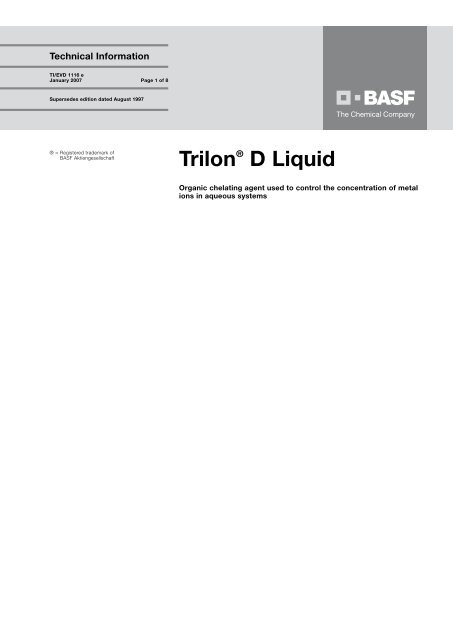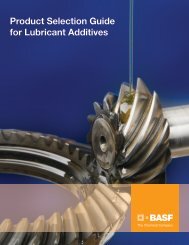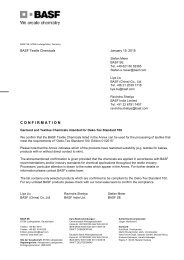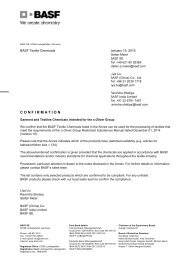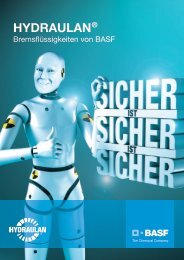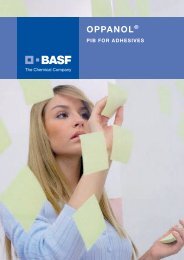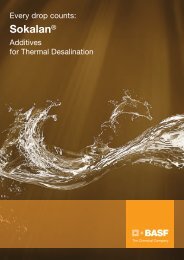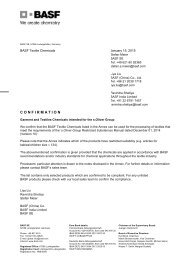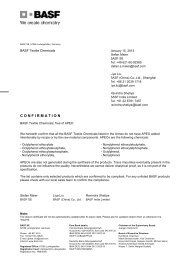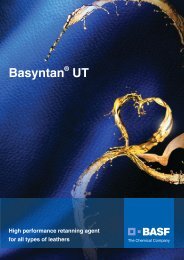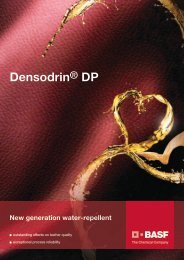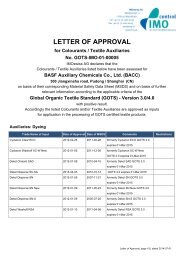Trilon® D Liquid - the Performance Chemicals division - BASF.com
Trilon® D Liquid - the Performance Chemicals division - BASF.com
Trilon® D Liquid - the Performance Chemicals division - BASF.com
- No tags were found...
Create successful ePaper yourself
Turn your PDF publications into a flip-book with our unique Google optimized e-Paper software.
Technical InformationTI/EVD 1116 eJanuary 2007 Page 1 of 8Supersedes edition dated August 1997® = Registered trademark of<strong>BASF</strong> AktiengesellschaftTrilon ® D <strong>Liquid</strong>Organic chelating agent used to control <strong>the</strong> concentration of metalions in aqueous systems
TI/EVD 1116 e January 2007 Page of 8 Trilon D <strong>Liquid</strong>ContentsPropertiesChemical nature Page 3Chemical and physical data Page 3Complex formation Page 4Chemical stability Page 6Corrosion Page 6Applications Page 7SafetyStorage Page 8Labelling Page 8Note Page 8
TI/EVD 1116 e January 2007 Page of 8 Trilon D <strong>Liquid</strong>PropertiesChemical natureThe active ingredient contained in Trilon D <strong>Liquid</strong> is hydroxyethylenediaminetriacetic acid (HEDTA or HEDTA-H 3) or its salts.Hydroxyethylenediaminetriacetic acid, C 10H 15N 2O 7, is an aminocarboxylicacid with six functional groups.HOCH 2CH 2CCOONaNCH 2CH 2NNaOOCCH 2H 2CH 2COONaTrilo D <strong>Liquid</strong>Aqueous solution of <strong>the</strong> trisodium salt of hydroxyethylenediaminetriaceticacid (HEDTA-Na 3)CAS No. 139-89-9Chemical and physical dataUnitTrilon D <strong>Liquid</strong>Physical form (visual) Clear, yellow liquidMolar mass (DIN 32625) g/mol 344Concentration (<strong>BASF</strong> method)*expressed as trisodium salt (HEDTA-Na 3) % approx. 40expressed as free acid (HEDTA-H 3) % approx. 32Density (DIN 51757, 20 °C, U-tube densitometer) g/cm 3 approx. 1.26pH (DIN 19268, 23 °C, 1% in water) approx. 11.5Hazen colour (DIN EN 1557) max. 250Volatile NH 3(<strong>BASF</strong> method) ppm max. 100Calcium binding capacity (<strong>BASF</strong> method, pH 11) mg CaCO 3/g t. q. approx. 125Water content (EN 13268) % approx. 56Viscosity (DIN 53018, 23 °C) mPa · s approx. 30Pour point (ISO 3016) °C < – 20Solubility in water (<strong>BASF</strong> method)25 °C g/l Miscible in all proportions80 °C g/lThe above information is correct at <strong>the</strong> time of going to press. It does not necessarily form part of <strong>the</strong> product specification.A detailed product specification is available from your local <strong>BASF</strong> representative.* Determined by potentiometric titration against iron(III)chloride.
TI/EVD 1116 e January 2007 Page of 8 Trilon D <strong>Liquid</strong>300Viscosity mPa·s250Trilon D <strong>Liquid</strong>200150100500-10 0 10 20 30Temperature (°C)Viscosity as a function of temperatureComplex formationThe most important property of Trilon D <strong>Liquid</strong> is its ability to form watersoluble<strong>com</strong>plexes with polyvalent ions (eg. calcium, magnesium, lead, copper, zinc, cadmium, mercury, manganese, iron, aluminium) over a widepH range from 2 to 13.5. HEDTA usually forms 1 : 1 <strong>com</strong>plexes, i. e. 1 mol ofHEDTA chelates binds to 1 mol of metal ions. The metal ion is <strong>com</strong>pletelyenclosed by <strong>the</strong> ligand. These <strong>com</strong>plexes remain stable, especially in alkalimedia and even at temperatures of up to 100 °C. [MeZ (m-n)- ]K = ––––––––––––– [Me n+ ] [Z m- ]From <strong>the</strong> law of mass action, <strong>the</strong> equation for <strong>the</strong> stability constant K for1 : 1 <strong>com</strong>plexes can be written as follows:where[MeZ (m-n)- ][Me n+ ]is <strong>the</strong> concentration of <strong>the</strong> chelate that is formedis <strong>the</strong> concentration of free, positively charged metalions[Z m- ] is <strong>the</strong> concentration of <strong>the</strong> ligand anion, in this caseHEDTAKis <strong>the</strong> stability constant for <strong>the</strong> chelate.
TI/EVD 1116 e January 2007 Page of 8 Trilon D <strong>Liquid</strong>Logarithmic stability constants (log K) for <strong>com</strong>plexes of HEDTA and selectedmetal ionsMetal ionlog KFe 3+ 19.8Cu 2+ 17.5Ni 2+ 17.1Zn 2+ 14.6Fe 2+ 12.2Mn 2+ 10.8Ca 2+ 8.2Mg 2+ 7.0HEDTA-H 3is a tribasic acid that dissociates in three steps. The acid dissociation constants pK aare as follows.HEDTA-H 3 pK a 1 2.6HEDTA-H- 2 pK a 2 5.3HEDTA-H 2- pK a 3 9.7In aqueous solutions, HEDTA <strong>com</strong>petes for metal ions with o<strong>the</strong>r anionssuch as hydroxide, sulphate, sulphide, carbonate and oxalate that formsparingly soluble metal salts. The formation of chelates reduces <strong>the</strong> concentrationof free metal ions [Me n+ ] to such an extent that <strong>the</strong> solubility productsof many sparingly soluble metal salts are no longer exceeded. The result isthat <strong>the</strong> salts no longer precipitate or may even redissolve.The high stability of <strong>the</strong>se <strong>com</strong>plexes prevents <strong>the</strong> metal ions from participatingin typical chemical reactions. For instance, manganese, iron and copper are no longer able to catalyse <strong>the</strong> de<strong>com</strong>position of peroxide bleach.Conditional stability constants [log K cond] take into account <strong>the</strong> stability constant K as well as <strong>the</strong> acid base dissociation equilibria.16log K cond14121086420Ca 2+Cu 2+Fe 3+Mg 2+Mn 2+0 2 4 6 8 10 12 14pHConditional stability constants for selected HEDTA chelates
TI/EVD 1116 e January 2007 Page of 8 Trilon D <strong>Liquid</strong>The table below shows <strong>the</strong> pH ranges in which HEDTA forms stable <strong>com</strong>plexes.1 g of Trilon D <strong>Liquid</strong> is able to sequester <strong>the</strong> following amounts of metalions, independently of <strong>the</strong> temperature.mg Metal ion pH rangeapprox. 47 Ca 2+ 8.5 – 11.0approx. 28 Mg 2+ 10.0 – 12.0approx. 74 Cu 2+ 3.0 – 11.0approx. 65 Fe 3+ 2.0 – 10.0Chemical stabilityTrilon D <strong>Liquid</strong> is chemically very stable.The Trilon D <strong>Liquid</strong> exhibit a higher stability than o<strong>the</strong>r organic chelatingagents such as citric acid, tartaric acid and gluconates – especially at elevated temperatures.Whereas inorganic sequestring agents (eg. phosphates) may hydrolyse athigh temperatures, Trilon D <strong>Liquid</strong> is stable – even when heated to 200 °Cunder pressure.CorrosionThe Trilon D <strong>Liquid</strong> is resistant to strong acids and bases. It is gradually broken down by chromic acid, potassium permanganate and o<strong>the</strong>r strongoxidizing agents. Stability in <strong>the</strong> presence of hydrogen peroxide, percarbonateand perborate is sufficient for joint application. Never<strong>the</strong>less, we do notre<strong>com</strong>mend <strong>com</strong>bining Trilon D <strong>Liquid</strong> and peroxides in liquid formulations.Sodium hypochlorite and o<strong>the</strong>r substances that release chlorine have ahighly detrimental effect on <strong>the</strong> performance of Trilon D <strong>Liquid</strong>. Alkaline earthand heavy metal <strong>com</strong>plexes are broken down.Trilon D <strong>Liquid</strong> stabilizes polyvalent metal ions, which means that it canincrease <strong>the</strong> rate at which metals dissolve. Never<strong>the</strong>less, with <strong>the</strong> exceptionof aluminium, an oxidizing agent such as air always has to be present forcorrosion to take place. Unalloyed steel is prone to corrosion in media thatcontain air, but corrosion can be reduced substantially if <strong>the</strong> pH is in <strong>the</strong>alkaline range and can be eliminated almost <strong>com</strong>pletely if oxygen and o<strong>the</strong>roxidizing agents are excluded. With <strong>the</strong> exception of aluminium, metals thatare cleaned in <strong>the</strong> slightly alkaline range, which is <strong>the</strong> optimum pH range forTrilon D <strong>Liquid</strong>, are much less prone to corrosion than if <strong>the</strong>y are cleanedwith acids. The only type of corrosion that has been observed with Trilon D <strong>Liquid</strong> isuniform corrosion: pitting or stress cracking have not been observed inmedia with a low chloride content. One of <strong>the</strong> advantages of Trilon D <strong>Liquid</strong>is that it can be supplied with a very low chloride content (< 20 mg/kg).The following information on materials is of a very general nature, becausecorrosion depends on many different factors such as exposure to air, galvanic corrosion caused by <strong>the</strong> presence of different materials and by <strong>the</strong>flow patterns of liquids. The <strong>com</strong>patibility of Trilon D <strong>Liquid</strong> with differentmaterials needs to be tested in each individual case.Austenitic stainless steels such as AISI/SAE 316 Ti and AISI/SAE 321 arevery effective for vessels that are used to store and transport Trilon D <strong>Liquid</strong>.Ferritic carbon steel such as ASTM A201 Grade B (European Material No. P265GH) is fairly resistant to Trilon D <strong>Liquid</strong>. A rate of corrosion of < 0.01 mm/a has been measured at 54 °C.Aluminium and aluminium alloys such as AL 7075 T6 (European Material No. 3.3465) are not resistant to Trilon D <strong>Liquid</strong>, because it is alkaline andaluminium is quickly corroded by strong bases.
TI/EVD 1116 e January 2007 Page of 8 Trilon D <strong>Liquid</strong>ApplicationsTrilon D <strong>Liquid</strong> forms more stable <strong>com</strong>plexes with iron(III) ions than o<strong>the</strong>rorganic <strong>com</strong>plexing agents in <strong>the</strong> strongly alkaline pH range. It forms <strong>com</strong>plexeswith Fe 3+ in <strong>the</strong> 2 – 10 pH range, but o<strong>the</strong>r <strong>com</strong>plexing agents aregenerally restricted to <strong>the</strong> acidic and neutral pH range.Stoichiometric amounts of Trilon D <strong>Liquid</strong> are required to <strong>com</strong>plex metalions. Solutions are clear after <strong>the</strong>y have been treated with chelating agents,and <strong>the</strong>y do not need to be filtered or decanted.Trilon D <strong>Liquid</strong> can be used to dissolve precipitated metal salts and hydroxides.Traces of free metal ions are always present in equilibrium with salts,even if <strong>the</strong>se salts are very sparingly soluble. If <strong>the</strong>se free ions are chelated,<strong>the</strong> equilibrium is gradually displaced in favour of <strong>the</strong> soluble chelates.The rate at which deposits dissolve depends on <strong>the</strong>ir crystal structure andage, and on <strong>the</strong> temperature. Increasing <strong>the</strong> temperature can help toincrease <strong>the</strong> rate at which precipitated solids dissolve.Old, dried-on scale has to be treated with Trilon D <strong>Liquid</strong> over a longer period, and we would re<strong>com</strong>mend applying 1 g/l more than <strong>the</strong> stoichiometric amount in this case.Solutions of Trilon D <strong>Liquid</strong> are much less susceptible to precipitation by acids and alkalis than solutions of o<strong>the</strong>r <strong>com</strong>plexing agents such as EDTA.Trilon D <strong>Liquid</strong> is approx. 6 % soluble in 30 % caustic soda, whereas EDTA-Na 4is only 0.5 % soluble in 30 % caustic soda. Trilon D <strong>Liquid</strong>’s higher stabilityallows it to be used in a wider range of formulations than <strong>the</strong> Trilon ® A typesor Trilon B types.SafetyWe know of no ill effects that could have resulted from using <strong>the</strong> Trilon D <strong>Liquid</strong> for <strong>the</strong> purpose for which it is intended and from processing itin accordance with current practice.According to <strong>the</strong> experience we have gained over many years and o<strong>the</strong>rinformation at our disposal, <strong>the</strong> Trilon D <strong>Liquid</strong> does not exert any harmfuleffects on health, provided that it is used properly, due attention is given to<strong>the</strong> precautions necessary for handling chemicals, and <strong>the</strong> information andadvice given in our Safety Data Sheets are observed.
TI/EVD 1116 e January 2007 Page of 8 Trilon D <strong>Liquid</strong>StorageTrilon D <strong>Liquid</strong> should not be stored at temperatures below 0 °C, becausethis can cause it to precipitate. It can be reconstituted by heating it briefly to40 – 50 °C and stirring.Trilon D <strong>Liquid</strong> is easily capable of being pumped at temperatures down to – 10 °C.Trilon D <strong>Liquid</strong> has a shelf life of one year in its tightly sealed original packaging.We would re<strong>com</strong>mend storing <strong>the</strong> Trilon D <strong>Liquid</strong> in tanks made from AISI 316 Ti or AISI 321 stainless steel.LabellingPlease refer to <strong>the</strong> latest Safety Data Sheets for detailed, up-to-date information on classification, labelling and product safety.NoteThe data contained in this publication are based on our current knowledge and experience. In view of <strong>the</strong> many factors that may affect processing and application of our product, <strong>the</strong>se data do not relieve processors from carrying out <strong>the</strong>ir own investigations and tests; nei<strong>the</strong>r do <strong>the</strong>se data imply any guarantee of certain properties, nor <strong>the</strong> suitability of <strong>the</strong> product for a specific purpose. Any descriptions, drawings, photographs, data, pro-portions, weights etc. given herein may change without prior information and do not constitute <strong>the</strong> agreed contractual quality of <strong>the</strong> product. It is <strong>the</strong> responsibility of <strong>the</strong> recipient of our products to ensure that any proprietary rights and existing laws and legislation are observed.January 2007<strong>BASF</strong> Aktiengesellschaft<strong>Performance</strong> <strong>Chemicals</strong> forDetergents and Formulators67056 Ludwigshafen, Germanywww.basf.<strong>com</strong>/detergents-formulators


